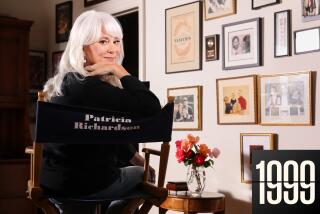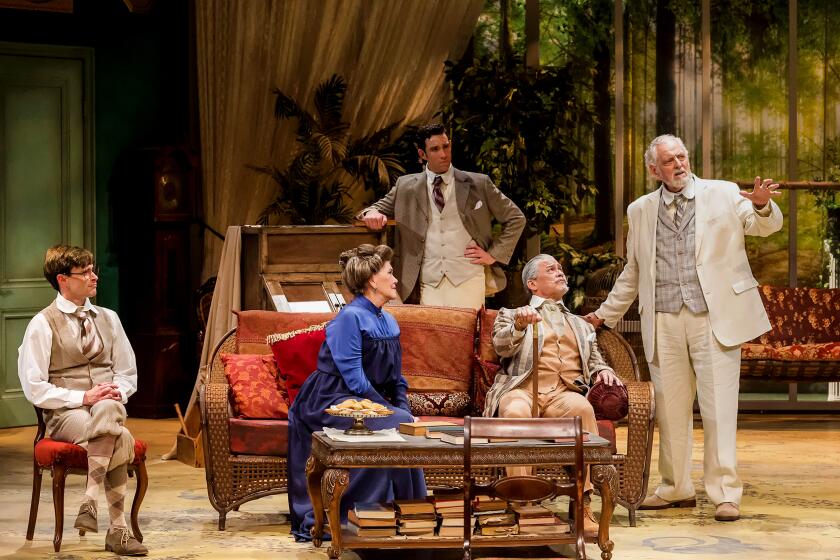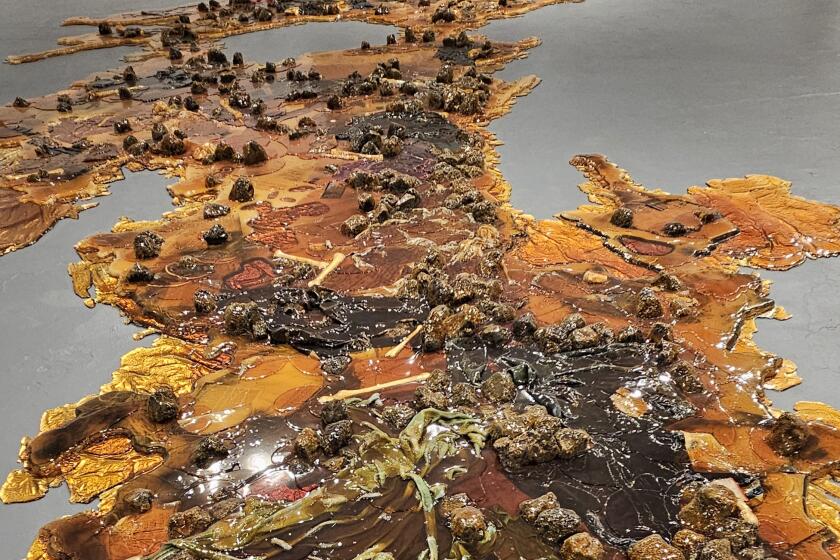ART REVIEW : Toning It Down at the Whitney : This year’s Biennial has passed on the strident polemics in favor of a broader view of today’s art.
The 1995 Whitney Biennial feels as if it’s engaged in a holding action--a careful survey exhibition meant to get us safely through an uncertain time, while promising not to repeat awesome mistakes of the past.
Currently the art world is adrift, with no dominant directions in sight. This Biennial--which was organized by the museum’s adjunct curator of drawings, Klauss Kertess, and which seems to have drawn more pre-show publicity than any Whitney Biennial in memory--follows a 1993 installment that was an unmitigated disaster.
Relax and look around , this year’s presentation seems to say. When something big happens, we’ll let you know.
So what clues does this Biennial have to offer about the present state of American art? Well, before we get into that, it’s necessary to say what the show is not about.
Two misconceptions have clouded the 1995 Biennial. One is a standard delusion, which clings to every such periodic survey exhibition the Whitney Museum of American Art puts together (this show is No. 68 in the series). The other misconception is an error oddly particular to the current installment.
The standard delusion is that the Biennial is--or can be--a cogent survey of recent American painting, sculpture, photography, video and film. It’s important to keep in mind that the Biennial isn’t a survey of the American art scene, but a survey of how art looks from an institutional vantage point in Manhattan. Awareness of the inevitable parochialism of all Whitney Biennials should simply be a given.
Here’s a rule of thumb: It’s easy to live in L.A. or Houston or Minneapolis and keep up with art in New York, but it requires huge effort to live in New York and keep up with art anywhere else in the United States. Every two years the Whitney demonstrates the rule.
For example, the seven painters, sculptors, photographers and installation artists chosen from Los Angeles have contributed some of the strongest and most consistent work in the galleries. But the idea that only seven artists working in L.A.--Toba Khedoori, Catherine Opie, Lari Pittman, Charles Ray, Jason Rhoades, Nancy Rubins and Diana Thater--can measure up against the rest of the exhibition is an absurdity. The five-to-one ratio of New Yorkers-to-Angelenos merely speaks of understandably local affiliations for a New York museum.
Kertess has said he traveled far and wide in preparation for selecting artists for this show, and that the longest period of time he spent in another city was 2 1/2 days; he spent those in Chicago. (Greer Lankton, who makes silly sculptures reminiscent of the late Wayland Flowers’ puppet, Madame, was the only Chicago-based artist to make the cut.) So, what could be expected?
(Video and film, by the way, almost always appear parenthetically in Biennial reviews, because only critics who specialize in those time-based genres typically sit through the long, staggered hours of programs. The review you’re reading is a case in point. Maybe film and video should be separated out and shown in its own off-year Biennial exhibition.)
The second and far more disappointing misconception about the art in the 1995 Biennial is widespread. It asserts that, in stark contrast to the art in the vilified 1993 Biennial, the curator has now thrown out politics in favor of poetics.
This cheerful view--usually uttered with relief, as if to suggest that the nasty business of political engagement has no business sullying the pristine world of art--is plainly reactionary. Worthy of Newt, its prominence among Biennial-watchers makes me queasy. Relief comes only in recognizing that Kertess hasn’t done anything of the kind.
You can’t have a show that features gifted painters like Sue Williams and Lari Pittman, or photographers like Cindy Sherman and Nan Goldin, all of whom engage sexuality and art in aggressive and wildly different ways, and claim that it’s apolitical. Instead, the shift Kertess made toward poetics is a pointed movement away from polemics , not politics.
The universally reviled 1993 Biennial had been marked by its fervent embrace of the harangue--that is, of art that regards aesthetics as, at best, beside the point, and at worst, an evil designed to lull dim and complacent viewers away from acknowledgment of the usually harsh political reality of the world. Somehow, a nutty conception that art is an activity in which enlightened artists condescend to ignorant audiences came to be seen as a really swell attitude for artists to adopt.
We forget too easily that all art has a political dimension--just as all politics has an artistic dimension--and that its political efficacy is inseparable from artistic skill. To judge art solely on prefigured political grounds, regardless of whether the politics are on the spectrum’s left or right, is to raise Philistinism to the highest plateau. The ’93 Biennial, with its emphasis on stupid sloganeering, did just that.
Kertess’ show gives that noxious ideal a good smack upside the head. There is almost nothing to read in this show’s art. You may disagree with a lot of his choices--I do--but you’re likely to do so on artistic grounds.
So, this Biennial is valuable as a curatorially clearheaded correction of the course. It would be a mistake to say that Kertess has tried to be a trend-monger, but a few tentative observations about his approach do emerge.
One is that installation art is no longer the leading edge. In fact, relatively few installations are in the show.
Some, such as Barry Le Va’s familiar, spatially complex dispersal of geometric concrete-blocks, which expands on ideas he has explored for 20 years, imply ancestral sources in Minimalist art for the proliferation of environmentally scaled installation in the last half-dozen years.
Others, such as Jason Rhoades’ compendium of homemade machinery, broken-down motorbikes, scavenged VCRs, a home doughnut-making machine and other all-American guy junk piled with abandon on a carpet in the center of a room, suggest that an academic edge has crept into the installation genre.
Like an explosion in a suburban rec room, Rhoades’ “My Brother/Brancusi” is a madly evocative collision between two entities ostensibly separated by an unbridgeable gulf: the engrossed tinkerer toiling away down in a basement shop and the driven artist obsessively at work in a studio. Home Improvement meets Artistic Engagement in “My Brother/Brancusi.”
*
Rhoades’ wonderful pile of salvage is crowded onto a big island of tatty carpeting, the way a sleek Brancusi sculpture sits in isolated splendor atop a specially carved pedestal. In a disappointing gesture, however, the artist has also added a kind of index: The room is ringed with paired photographs--famous ones of the great Romanian sculptor in his Parisian studio and photo-album ones of (apparently) Rhoades’ brother awkwardly posed in a suburban living room.
These pictures turn a crazily inventive installation into a graduate school critique prepared to “explain” the sculpture to confused visitors. Installation was born of the wholesale institutionalization of contemporary art, on which the genre depends, and Rhoades’ pedagogical pictures are depressingly like a photographic docent tour.
Painting, which has died repeated deaths in recent decades, is back in force in the 1995 Biennial. Kertess has made a point of giving pride of place to the conventional practice of putting paint on rectangles this time out, with work by more than two dozen painters on view. They’re all over the map.
A passel of long-established influential artists--Brice Marden, Cy Twombly, Robert Ryman, Agnes Martin--looks merely dutiful here. A few older painters--Jane Freilicher, Milton Resnick, John O’Reilly, Peter Saul--are seemingly offered as having been overlooked in prior Biennials (Freilicher was last at the Whitney in 1972; the rest are having their Biennial debuts).
Among the younger generations, Lari Pittman’s big, brash, go-for-broke extravaganzas of lust, death, glamour, madness and commemorative bliss remain the most invigorating paintings being made today. They blow away everything else on the walls.
Sue Williams is making crabbed, low-key, strangely subversive pictures in which painting operates on a pleasure/pain principle. Formally, they recall the disjunctive images of early David Salle, as if she had decided to go back to where he started in an effort to redirect his quintessentially 1980s aesthetic into a radically different place. Keep an eye on these.
The most thoroughly discredited styles of painting made since the 1960s--Color Field, Op, Pattern and Decoration--are eccentrically melded by Philip Taaffe, who somehow comes up with the most gorgeously seductive abstractions you’ll see anywhere. These paintings don’t merely justify their mural scale, they demand it.
Two young painters (both are 30) with very short resumes make a substantial impression in their New York debuts. Khedoori and Boston’s Ellen Gallagher both create big, simple, elegantly spare fields as the lush surface for obsessive renderings--small, sexy, abstract shapes for Gallagher, windows on a building facade and linked cars on a train for Khedoori--that are ruminative in the extreme.
Kertess has also made a slight adjustment in the idea of “American” art, having chosen to include two Mexican and two Canadian artists. But don’t expect surprises.
The Mexicans--Julio Galan, whose dandyish, self-possessed paintings are not among this gifted painter’s best, and Gabriel Orozco, whose disorienting sculpture is a free-standing elevator cabin that is claustrophobically smaller than normal--both maintain studios in New York as well as Mexico.
The Canadians--Jeff Wall, whose big Cibachrome transparencies mounted in giant light-boxes aspire to the stature of Postmodern murals, and Stan Douglas, whose projected-film installation was not open when I saw the show, thanks to a technical mishap--are already fixtures on the European art scene, the back door through which many non-New Yorkers make an entrance into Manhattan.
There are other highlights to this Biennial. Among them are Nancy Rubins’ big suspended cloud of bound-up mattresses smeared with frosted cake, an industrial-strength effort that is disarmingly playful; Charles Ray’s little self-portrait sculpture as a three-dimensional puzzle trapped inside a glass bottle, like a rescue message tossed into the sea; Cindy Sherman’s photographs of scarred and mutilated dolls, which are in part shocking because of the almost unbelievable consistency of quality in this remarkable artist’s work during the last 15 years.
Disappointments will also be found. Perhaps the most notable is Jack Pierson’s sunny, photographic mural of flowers framed by images of fading boyishness and tousled hair, which principally demonstrates the thinness of lifestyle as an animating gesture for art.
These and other successes and failures are singular examples, however; neither one is in such abundance that you can get really worked up about the show as a whole. It feels, well, pleasant. Likable. Occasionally challenging, usually not.
Still, if Kertess did nothing else but throw a monkey wrench into the academically powered machinery that is forever threatening to swallow art whole, this Biennial would be worth it. He did, and it is.
* Whitney Museum of American Art, 945 Madison Ave., New York, Closed Monday and Tuesday. Through June 4. (212) 570-3676.
More to Read
The biggest entertainment stories
Get our big stories about Hollywood, film, television, music, arts, culture and more right in your inbox as soon as they publish.
You may occasionally receive promotional content from the Los Angeles Times.







